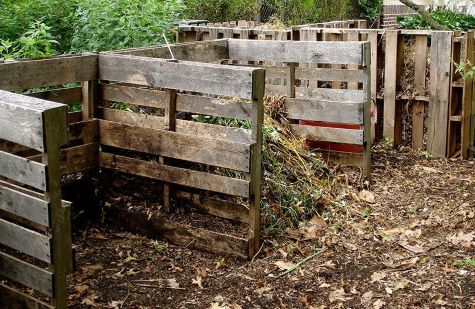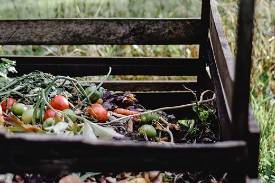Starting a Compost Bin

With fall comes quite a few different activities including cleaning the garden, raking up excess leaves and possibly preserving the last of your fall produce. With all of that plant material available, fall can be the perfect time to start a compost pile.
Compost is nature’s way of transforming organic material into a form usable by plants. Compost by definition is a mix of soil and rotted or decomposed organic material that has been transformed into material usable by plants by bacteria, fungi, microorganisms and air. Once it has decomposed this organic material can be incorporated into vegetable gardens, as a thin layer in lawns and used as mulch in flower beds. Compost is created using a combination of “brown” and “green” materials with beneficial decomposers, moisture and air (more on that later). In nature, composting is a slow process, however, with the proper planning composting can be a relatively quick process in the home garden.
 When planning a compost bin the first step is to figure out where to put it. While compost piles need to stay damp to encourage faster decomposition, the bin should not be located in an area that stays consistently wet or holds water. Most people put their bins in an easily accessible, but out of the way location that is near their garden or flower beds. It is beneficial to have a water source nearby to keep the organic material damp but that is not a requirement. Composting can be made in a pit, using a bin or using a compost tumbler. How you compost will ultimately be up to your personal preferences and the amount of material you produce. Growing up we had a big compost pile that we threw organic material on and my dad would turn it with a skid steer periodically to facilitate the breaking down of material, it a back yard a compost pile should be in some type of enclosure to keep pets out of the material. One of the cheapest types of bins to make is using wooden pallets similar to the photo above however woven wire, cement bricks or other lumber works just as well. There are also commercial compost bins or tumblers available that work equally as well. Many people have multiple bins side by side and move the compost from one bin to another as it decomposes similar to the photo above.
When planning a compost bin the first step is to figure out where to put it. While compost piles need to stay damp to encourage faster decomposition, the bin should not be located in an area that stays consistently wet or holds water. Most people put their bins in an easily accessible, but out of the way location that is near their garden or flower beds. It is beneficial to have a water source nearby to keep the organic material damp but that is not a requirement. Composting can be made in a pit, using a bin or using a compost tumbler. How you compost will ultimately be up to your personal preferences and the amount of material you produce. Growing up we had a big compost pile that we threw organic material on and my dad would turn it with a skid steer periodically to facilitate the breaking down of material, it a back yard a compost pile should be in some type of enclosure to keep pets out of the material. One of the cheapest types of bins to make is using wooden pallets similar to the photo above however woven wire, cement bricks or other lumber works just as well. There are also commercial compost bins or tumblers available that work equally as well. Many people have multiple bins side by side and move the compost from one bin to another as it decomposes similar to the photo above.
Once you have figured out the location of your compost pile and built it it’s time to start composting. Compost should consist of “brown” and “green” materials. Brown materials provide the carbon needed in the pile. These materials are usually dry, hence why we call them brown, and provide air movement and food for the decomposers to eat on. Brown materials consist of: leaves, straw, saw dust, dryer lint, pine needles, etc. You should have at least twice as many browns as you have greens. Green materials provide the nitrogen needed to feed the decomposers. They help the decomposers grow and multiply. These materials include: grass clippings, kitchen waste (egg shells, peelings, scraps), flowers, coffee grounds, hair, manure and weeds (without seeds). There are several items that should never be added to the compost pile as they can lead to animals getting in the pile or disease and insect issues in the future. These items include: diseases or insect infested plants, pet waste, meat or dairy products, weeds with seeds in them, and poisonous plants.
least twice as many browns as you have greens. Green materials provide the nitrogen needed to feed the decomposers. They help the decomposers grow and multiply. These materials include: grass clippings, kitchen waste (egg shells, peelings, scraps), flowers, coffee grounds, hair, manure and weeds (without seeds). There are several items that should never be added to the compost pile as they can lead to animals getting in the pile or disease and insect issues in the future. These items include: diseases or insect infested plants, pet waste, meat or dairy products, weeds with seeds in them, and poisonous plants.
There are two methods of composting, hot composting or cold composting. Hot composting is the faster method however it involves collecting the materials needed to create a pile all at once while cold composting takes longer but can be more user friendly by throwing materials into the pile as you have them and not layering the materials. To start a hot compost pile collect all the materials and then follow this patter: Start the pile with a six to eight-inch layer of brown materials on the bottom of the pile, then add a two to three-inch layer of green materials and repeat until you have a pile approximately three feet by three feet. If green materials are in short supply you can add manure or a high nitrogen fertilizer sprinkled throughout the pile to add the necessary food for the decomposers. Water the pile in well and water it every week if it doesn’t rain. Watch the temperature of the pile, it should slowly rise to approximately 150-160 degrees and then  slowly decrease. Once it starts to cool down turn the pile using a pitchfork which should cause it to heat up again. A hot compost pile should be ready in four to six months. Cold composting takes longer, up to a year, however you can add to the pile whenever you like. Try to keep the browns to greens at a ratio of 2 to 1 and keep the pile damp while turning it periodically. The compost is ready to use when there is no recognizable plant material and the organic matter is dark brown and crumbly.
slowly decrease. Once it starts to cool down turn the pile using a pitchfork which should cause it to heat up again. A hot compost pile should be ready in four to six months. Cold composting takes longer, up to a year, however you can add to the pile whenever you like. Try to keep the browns to greens at a ratio of 2 to 1 and keep the pile damp while turning it periodically. The compost is ready to use when there is no recognizable plant material and the organic matter is dark brown and crumbly.

Have questions? Contact our office where our Horticulture Extension Agent will assist you with questions.
Phone: (316) 321-9660
Email: callae@ksu.edu